


SH-60 LAMPS MK III Seahawk
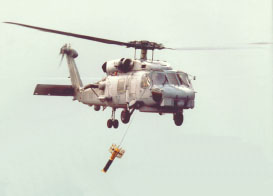 The Seahawk is a twin-engine helicopter. It is used for anti-submarine warfare, search and
rescue, drug interdiction, anti-ship warfare, cargo lift, and special operations. The Navy's SH-60B
Seahawk is an airborne platform based aboard cruisers, destroyers, and frigates and deploys sonobouys
(sonic detectors) and torpedoes in an anti-submarine role. They also extend the range of the ship's radar
capabilities. The Navy's SH-60F is carrier-based. Some versions, such as the Air Force's MH-60 G Pave Hawk and the Coast Guard's HH-60J Jayhawk, are equipped with a rescue hoist with a 250 foot (75 meter) cable that has a 600 pound (270 kg) lift capability, and a retractable in-flight refueling probe.
The Army's UH-60L Black Hawk can carry 11 soldiers or 2,600 pounds (1,170 kg) of cargo or sling load 9,000 pounds (4,050 kg) of cargo.
The UH-60 Black Hawk was fielded by the Army in 1979. The Navy received the SH-60B Seahawk in 1983 and the SH-60F in 1988. The Air Force received the MH-60G Pave Hawk in 1982 while the Coast Guard received the HH-60J Jayhawk in 1992.
The SH-60B typically has a crew of three: a pilot, an airborne
tactical officer (ATO) and a sensor operator, or �senso.� The ATO is
responsible for the tactical situa-tion, deciding what assets will be
used to prosecute the target and handling the coordination of other
assets on scene. The sensor operator is an enlisted Sailor who operates
the radar and magnetic anomaly detector (MAD) equipment, interprets acoustic data and performs SAR rescues. All sensos must maintain their qualifications
as rescue swimmers.
The Seahawk is a twin-engine helicopter. It is used for anti-submarine warfare, search and
rescue, drug interdiction, anti-ship warfare, cargo lift, and special operations. The Navy's SH-60B
Seahawk is an airborne platform based aboard cruisers, destroyers, and frigates and deploys sonobouys
(sonic detectors) and torpedoes in an anti-submarine role. They also extend the range of the ship's radar
capabilities. The Navy's SH-60F is carrier-based. Some versions, such as the Air Force's MH-60 G Pave Hawk and the Coast Guard's HH-60J Jayhawk, are equipped with a rescue hoist with a 250 foot (75 meter) cable that has a 600 pound (270 kg) lift capability, and a retractable in-flight refueling probe.
The Army's UH-60L Black Hawk can carry 11 soldiers or 2,600 pounds (1,170 kg) of cargo or sling load 9,000 pounds (4,050 kg) of cargo.
The UH-60 Black Hawk was fielded by the Army in 1979. The Navy received the SH-60B Seahawk in 1983 and the SH-60F in 1988. The Air Force received the MH-60G Pave Hawk in 1982 while the Coast Guard received the HH-60J Jayhawk in 1992.
The SH-60B typically has a crew of three: a pilot, an airborne
tactical officer (ATO) and a sensor operator, or �senso.� The ATO is
responsible for the tactical situa-tion, deciding what assets will be
used to prosecute the target and handling the coordination of other
assets on scene. The sensor operator is an enlisted Sailor who operates
the radar and magnetic anomaly detector (MAD) equipment, interprets acoustic data and performs SAR rescues. All sensos must maintain their qualifications
as rescue swimmers.
LAMPS is the acronym for Light Airborne Multipurpose System. The SH-60B helicopter is configured specifically in response to the LAMPS requirement of the U.S. Navy. The LAMPS MK III system bas been designed to the Navy's sea control mission. In fulfilling the mission, LAMPS MK III will encounter a threat that has many dimensions. The threat encompasses a hostile submarine fleet and missile-equipped surface ships. The system extends the search and attack capabilities of LAMPS MK III configured destroyer, frigate, and cruiser platforms,deploying helicopters directly from these ships.
The primary missions of the LAMPS MK III are those of ASUW and ASW. Aircraft prior to BUNO 162349 are capable of the antiship surveillance and targeting (ASST) and ASW roles only. Effective with BUNO 162349 and subsequent, LAMPS MK III are equipped to employ the Mk 2 Mod 7 Penguin missile. LAMPS MK III equipped with the missile can be used in the additional role of ASUW attack.
In an ASW mission, the aircraft is deployed from the parent ship to classify, localize, and potentially attack when a suspected threat has been detected by the ship's towed-array sonar, hull-mounted sonar, or by other internal or external sources.
When used in an ASUW mission, the aircraft provides a mobile, elevated platform for observing, identifying, and localizing threat platfoms beyond the parent ship's radar and/or electronic support measure (ESM) horizon. When a suspected threat is detected, classification and targeting data is provided to the parent ship via the datalink for surface-to-surface weapon engagement. Penguin missile equipped aircraft may conduct independent or coordinated attack, dependent upon the threat and tactical scenario.
Secondary missions include search and rescue (SAR), medical evacuation
(MEDEVAC), vertical replenishment (VERTREP), naval gunfire support (NGFS), and
communications relay (COMREL). In the VERTREP mission, the aircraft is able to transfer material and personnel between ships, or between ship and shore. In the SAR mission, the aircraft is designed to search for and locate a particular target/object/ship or plane and to rescue personnel using the rescue hoist. In the MEDEVAC mission, the aircraft provides for the medical evacuation of ambulatory and
litterbound patients. In the COMREL mission, the aicraft serves as a receiver and transmitter relay station for over-the-horizon (OTH) communications between units.
In the NGFS mission, the aircraft provides a platform for spotting and controlling naval gunfire from either the parent ship or other units.
Equipment of the SH-2G includes an AQS-18A dipping sonar, an ARR-84 sonobuoy receiver, AQS magnetic anomaly detector, LN-66 radar and AKT-22 data link. Also, a 600 kg rescue hoist can be installed. Small arms mountings for guns and 2.75 inch rockets are available. The SH-60F uses a variable depth sonar and sonobuoys to detect and track enemy submarines. Detection is primarily accomplished by using the AQS-13F dipping sonar which is deployed on a 1575 foot cable while the aircraft hovers 60ft above the ocean. The pilots are assisted in maintaining their 60ft day or night all weather hover by an automatic flight control system.
There are two data link antennas--one forward and one aft on the underside of the aircraft. The search radar antenna is also located on the underside of the aircraft. Other antennas (UHF/VHF, HF, radar altimeter, TACAN, ESM, sonobuoy receivers, doppler, ADF, IFF, and GPS) are located at various points on the helicopter. The left inboard, left outboard, and right weapon pylons accommodate BRU-14/A weapon/stores racks. Fittings for torpedo parachute release lanyards are located on the fuselage aft of each weapon pylon. Effective on BUNO 162349 and subsequent, the left and right inboard pylons have wiring and tubing provisions for auxiliary fuel tanks. All pylons have wiring provisions to accommodate the MK 50 torpedo. The left outboard weapon pylon can accommodate a missile launch assembly (MLA) which is used to mount the MK 2 MOD 7 Penguin air-to-surface missile.
The magnetic anomaly detector (MAD) towed body and reeling machine are mounted on a faired structure that extends from the forward tail-cone transition section on the right side of the aircraft. It is positioned above and aft of the right weapon pylon.
The sonobuoy launcher is located on the left side of the aircraft above the left weapon pylon. The sonobuoy launcher is loaded from ground level outside the aircraft. Sonobuoys are pneumatically launched laterally to the left of the aircraft.
The airborne RAST system main probe and external cargo hook are on the bottom fuselage centerline, just aft of the main rotor center line. Fuel service connections, for both gravity and pressure refueling, are located on the left side of the
aircraft aft of the weapon pylons. Dual-engine waterwash is manifolded from a single-point selector valve connector on the left side of the aircraft above the sensor operator's (SO) window. The long strokes of both main and tail wheel oleos are designed to dissipate high-sink-rate landing energy. Axle and high-point tiedowns are provided at each main gear. Fuselage attachments are provided above the tail gear for connection to the RAST tail-guide winch system allowing aircraft maneuvering and straightening aboard ship (41k) and for tail pylon tiedown. Emergency flotation bags are installed in the stub wing fairing of the main landing gear on both sides of the aircraft.
The easiest way to externally
identify a LAMPS helicopter is the
large cylindrical fairing under the
nose, housing the 360-degree-
a MAD, an electronic surveillance/
support measures (ESM) system,
missile jamming equipment and
missile plume detectors. The SH-60B
can be armed with both MK
46 and MK 50 torpedoes and a
single M60 machine gun.
A recent SH-60B modification
incorporated the ability to carry the
AGM-119B Penguin missile, giving
the Seahawka potent surface
strike capability. The Global
Positioning System has also
become standard equipment on
most SH-60Bs. Some LAMPS MK
III Seahawksalready carry Hellfire
missiles and night vision goggles.
In addition, funding has been allo-cated
to retrofit all SH-60Bs in the
HSL community with forward-looking
infrared (FLIR) sensors.
SH-60R
The Navy�s Helicopter Master Plan prescribes reducing the variety of operational helicopters in fleet service to one primary aircraft. Plans to remaanufacture and upgrade the current fleet of Sikorsky-built H-60 S Seahawks and to procure Sikorsky�s CH-60 utility helicopter are putting the Navy closer to a achieving that goal. Within the next two decades, anyone flying in a US Navy fleet helicopte will almost assuredly be flying one of two HH-60 versions -- the SH-60R or the CH-60. The Helicopter Master Plan calls for the remanufacture of SH-60B, SH-60F and HH-60H Seahawks into a common, more versatile SH-60R configuration that will meet Navy requirements through 2015. The SH-60R will combine the traditional mission areas of the SH-60B and SH-60F, but will be more capable. With the Navy�s helicopter antisubmarine (HS) and helicopter antisubmarine light (HSL) squadrons operating the same helicopter, opportunities for adjustments in the force structure will emerge, such as reducing the number of fleet readiness squadrons that support the SH-60 fleet. The distinction between the HS and HSL communities may even disappear altogether.
The SH-60(R) Multi-Mission Helicopter Upgrade (formally called LAMPS MK III Block II Upgrade) brings improvements to the SH-60 B/F helicopters now in the fleet. The SH-60R program will give Seahawks a life extension to 20,000 flight hours, to provide a multi-mission platform capable of conducting undersea and surface warfare for the next 20 to 25 years. This upgrade improves the capability of the LAMPS MK III Weapons System to provide battle group protection and to add significant capability in coastal littorals and regional conflicts. The SH-60R�s systems will be able to deal with high numbers of air and sea contacts in a confined space, in shallow water. It will operate with a carrier group, or with a surface action group, where no air cover is available. To fight and survive in this environment, detection systems will be added to the SH-60R that include a new multimode radar, FLIR sensor, ESM system and a retrievable, active, low-frequency sonar with significantly greater processing power.
Improvements include the addition of two stores stations, a data bus, advanced low-frequency sonar, acoustic processor, multimode radar, Forward-Looking Infrared (FLIR) sensor, upgraded ESM system and integrated self-defense system. The MAD gear will be deleted. Cockpit mission system improvements include the addition of an upgraded mission computer, improved communications suite, high-resolution displays, programmable keysets and tactical aids. The SH-60R will carry AGM-119 Penguin antishipping missiles and AGM-114 Hellfire anti-armor missiles, as well as the current MK 46 and MK 50 ASW torpedoes and a door-mounted 7.62 mm machine gun.
The Upgrade represents a significant avionics modification to the SH-60 series aircraft enhancing USW, ASUW, surveillance and ID and power projection, supporting the operational requirements of full-dimensional protection. The Upgrade develops the Airborne Low Frequency Sonar (ALFS) and increases sonobuoy and acoustic signal processing using the UYS-2A Enhanced Modular Signal Processor. In addition, the aircraft will employ a Multi-Mode Radar (MMR), (including Inverse Synthetic Aperture Radar (ISAR) and imaging and periscope detection modes), an ESM upgrade, and a fully automated self protection system. The improved electronics surveillance measures system (ESM) will enable passive detection and targeting of radar sources not currently detectable. The added multi-mode radar includes an inverse synthetic aperture radar mode (permits stand-off classification of hostile threats). Additionally, the aircraft will employ a Forward Looking Infrared (FLIR) sensor, with laser designator and capability to launch Hellfire missiles.
The Airborne Low Frequency Sonar (ALFS) and increased sonobuoy processing capability for the SH-60 helicopter will maintain and improve undersea warfare mission effectiveness against the quiet submarine threat in deep and shallow water environments. The ALFS project provides a dipping sonar with demonstrated capabilities typically 3 to 6 times (square miles of ocean searched per hour) the existing deep water capability. This improvement will significantly increase battle group and independent ship protection providing improved survivability and operating flexibility. ALFS
provides longer detection ranges and a greater detection capability by using lower frequencies, less signal attenuation, longer pulse lengths, improved processing and increased transmission power. ALFS utilizes the Enhanced Modular Signal Processor, designated UYS-2A, for improved sonobuoy processing capability.
LAMPS MK III completed OPEVAL in February 1982 and was found to be effective and suitable. FOT&E which tested the LAMPS MK III Block I Upgrade was completed in 1993 with similar results. The Block II Upgrade entered EMD in FY93 and building on the Block I Baseline, includes major avionics modifications. The Navy plans to install this upgrade in former SH-60B, SH-60F or HH-60H airframes that have undergone "remanufacture" in the H-60 Service Life Extension Program (SLEP), the resultant aircraft to be designated a SH-60R.
Although the airframe itself is not new, the SH-60R program has considerable risk due to the reliability problems with ALFS, higher than expected false alarm rates on the Advanced Radar Detection and Discrimination (ARPDD) program of the MMR, anticipated additional problems with the MMR and incorporation of a new cockpit that will be common to the CH-60.
Remanufacture of the SH-60B fleet has started and will continue through FY 2009. Remanufacture of the SH-60F and HH-60H fleets will begin in FY 2004 and continue through FY 2012. Lockheed Martin is the prime contractor for low-rate initial production of four SH-60Rs, with Sikorsky as major subcontractor. The SH-60R is scheduled to reach operational capability in 2002.
| SH-60B AIRCRAFT
DESCRIPTION Contractor:
Loral Federal Systems
(Prime), Sikorsky Aircraft Corp.
Type:
Maritime twin-turbine
helicopter with folding single main rotor and tail rotor
dynamic system
Power Plant:
- Two General Electric
T700-GE-401C turboshaft engines coupled to a
3,400 shaft horsepower transmission
- Each engine can
produce 1,662 shaft horsepower
Crew:
- Pilot
- Airborne Tactical
Office/Copilot
- Sensor Operator
Performance:
- Range: 450 nautical
miles
- Mission Endurance: 4
hours
- Dash Speed: 160 knots
- Service Ceiling:
13,000 feet DA
- Rate of Climb (at sea
level): 1,800 ft/min
- Rate of Climb with
One Engine (at sea level): 480 ft/min
Countermeasures:
Not applicable
Armament:
Three external store
stations for two MK-46/50 torpedoes and one AGM-119B
Penguin air-to-surface missile.
Mission and
Capabilities:
- Combat-capable,
multi-mission helicopter
- Currently operates
from U.S. Navy frigates and cruisers
- LAMPS (Light Airborne
Multi-Purpose System) extends the ship's horizon
of engagement by 100 nautical miles or more by
providing an airborne platform from which
all-weather detection, classification,
localization, and interdiction of submarines and
surface ships can be performed.
- Missions include:
Undersea Warfare (USW), Anti-Surface Warfare
(ASUW), Anti-Ship Surveillance and Targeting
(ASST), as well as utility missions such as
vertical replenishment and communications relay.
- Equipped with radar,
Electronic Support Measures (ESM), Global
Positioning System (GPS), acoustic sensing, and
on-board mission and acoustic processors.
- Has a secure,
dedicated, high-speed data link.
- Although processing
of acoustic, ESM, and sensor data can be
performed aboard the aircraft, LAMPS uses the
data link for real-time communication between
ship and air platforms, which minimizes verbal
interface and significantly increases combat
effectiveness.
- Airframe has enhanced
corrosion protection, an emergency flotation
system, a rescue hoist, and a 6,000 pound
external cargo hook.
- Shipboard
compatibility is enhanced with automatic blade
fold, manual tail pylon fold, and a Recovery,
Assist, Secure, and Traversing (RAST) system.
- An automatic flight
control system provides redundant stability
augmentation and autopilot capabilities.
- Expanded night
capabilities will be provided with the Forward
Looking Infra-Red (FLIR) system (available in
1996).
Program Summary:
- First production
contract signed in 1980.
- Since 1980, 175
aircraft have been delivered; six were procured
by the Spanish Navy and have been operating
successfully in conjunction with NATO forces
since 1988.
- In 1989, a Block I
improvement program resulted in the full system
integration of GPS, self-defense systems, Penguin
missile, MK-50 torpedo, and an improved sonobuoy
receiver.
- A Block II
improvement program is currently being planned
that will further enhance the system's
versatility by adding a low-frequency dipping
sonar, a multi-mode radar subsystem, and
improvements to the aircraft's survivability
systems, data link, communications system, and
operator interfaces.
|
H-60 TECHNICAL DATA:
External
Dimensions
| Main rotor
diameter |
16.36m |
| Main rotor blade
chord |
0.53m |
| Tail rotor
diameter |
3.35m |
| Tail rotor blade
chord |
|
| Distance between
rotor centers |
|
| Wing span |
|
| Wing aspect ratio |
|
| Length: overall,
rotors turning |
19.76m |
- fuselage
|
15.26m |
| Width overall |
2.36m |
| Height: (to top
of rotor) head |
3.79m |
| Overall height,
(tail rotor turning) |
5.18m |
| Ground clearance,
main rotor, turning |
|
| Elevator span |
|
| Width over skids |
|
Areas
| Main rotor blades
(each) |
4.34m2 |
| Tail rotor blades
(each) |
0.41m2 |
| Main rotor disc |
210.15m2 |
| Tail rotor disc |
8.83m2 |
| Vertical fin |
3.00m2 |
| Horizontal tail
surfaces |
4.18m2 |
Weights and Loadings
| Weight empty
(ASW) |
6.191kg |
| Mission fuel load
(usable) |
|
| Maximum useful
load (fuel and disposable ordinance) |
|
| Maximum takeoff
and landing weight |
|
| Maximum disc
loading |
47.2kg/m2 |
| Maximum power
loading |
3.92kg/m2 |
Performance
Sources and Resources
- Upgraded SH-60R rolls out Tester August 19, 1999 -- Lockheed Martin Federal Systems in Owego, N.Y., together with the Navy, celebrated the rollout of the first fully upgraded SH-60R multi-mission prototype helicopter Aug 5.
- Boeing Sikorsky Seahawk
http://www.fas.org/man/dod-101/sys/ac/sh-60.htm
Maintained by Robert Sherman
Originally created by John Pike
Updated Monday, December 27, 1999 5:25:18 PM

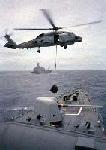
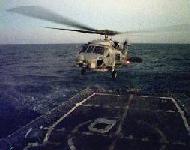
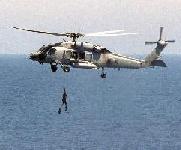
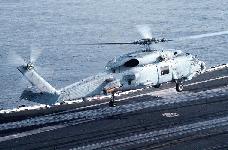
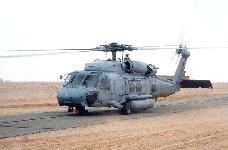

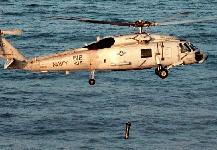
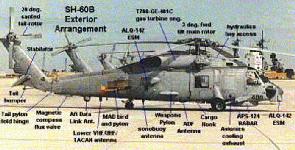



 The Seahawk is a twin-engine helicopter. It is used for anti-submarine warfare, search and
rescue, drug interdiction, anti-ship warfare, cargo lift, and special operations. The Navy's SH-60B
Seahawk is an airborne platform based aboard cruisers, destroyers, and frigates and deploys sonobouys
(sonic detectors) and torpedoes in an anti-submarine role. They also extend the range of the ship's radar
capabilities. The Navy's SH-60F is carrier-based. Some versions, such as the Air Force's MH-60 G Pave Hawk and the Coast Guard's HH-60J Jayhawk, are equipped with a rescue hoist with a 250 foot (75 meter) cable that has a 600 pound (270 kg) lift capability, and a retractable in-flight refueling probe.
The Army's UH-60L Black Hawk can carry 11 soldiers or 2,600 pounds (1,170 kg) of cargo or sling load 9,000 pounds (4,050 kg) of cargo.
The UH-60 Black Hawk was fielded by the Army in 1979. The Navy received the SH-60B Seahawk in 1983 and the SH-60F in 1988. The Air Force received the MH-60G Pave Hawk in 1982 while the Coast Guard received the HH-60J Jayhawk in 1992.
The SH-60B typically has a crew of three: a pilot, an airborne
tactical officer (ATO) and a sensor operator, or �senso.� The ATO is
responsible for the tactical situa-tion, deciding what assets will be
used to prosecute the target and handling the coordination of other
assets on scene. The sensor operator is an enlisted Sailor who operates
the radar and magnetic anomaly detector (MAD) equipment, interprets acoustic data and performs SAR rescues. All sensos must maintain their qualifications
as rescue swimmers.
The Seahawk is a twin-engine helicopter. It is used for anti-submarine warfare, search and
rescue, drug interdiction, anti-ship warfare, cargo lift, and special operations. The Navy's SH-60B
Seahawk is an airborne platform based aboard cruisers, destroyers, and frigates and deploys sonobouys
(sonic detectors) and torpedoes in an anti-submarine role. They also extend the range of the ship's radar
capabilities. The Navy's SH-60F is carrier-based. Some versions, such as the Air Force's MH-60 G Pave Hawk and the Coast Guard's HH-60J Jayhawk, are equipped with a rescue hoist with a 250 foot (75 meter) cable that has a 600 pound (270 kg) lift capability, and a retractable in-flight refueling probe.
The Army's UH-60L Black Hawk can carry 11 soldiers or 2,600 pounds (1,170 kg) of cargo or sling load 9,000 pounds (4,050 kg) of cargo.
The UH-60 Black Hawk was fielded by the Army in 1979. The Navy received the SH-60B Seahawk in 1983 and the SH-60F in 1988. The Air Force received the MH-60G Pave Hawk in 1982 while the Coast Guard received the HH-60J Jayhawk in 1992.
The SH-60B typically has a crew of three: a pilot, an airborne
tactical officer (ATO) and a sensor operator, or �senso.� The ATO is
responsible for the tactical situa-tion, deciding what assets will be
used to prosecute the target and handling the coordination of other
assets on scene. The sensor operator is an enlisted Sailor who operates
the radar and magnetic anomaly detector (MAD) equipment, interprets acoustic data and performs SAR rescues. All sensos must maintain their qualifications
as rescue swimmers.